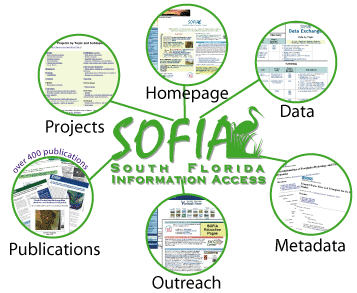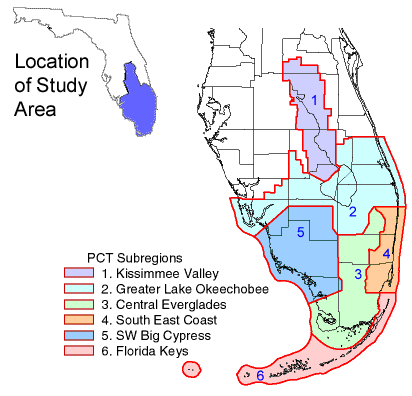
|
SOFIA Mission Statement
|
Introduction
The South Florida Ecosystem Program -- a part of the USGS Ecosystem Program
The South Florida Ecosystem Program is one of several study areas within the USGS Ecosystem Program. The Ecosystem Program was established to enable the USGS to enhance its scientific assistance to resource managers who require an improved scientific information base to resolve or prevent complex resource conflicts or environmental problems in specific ecosystem sites.  Through 3-5-year efforts in each ecosystem site, USGS intensifies its provision of scientific information tailored to the specific management needs of that ecosystem. The information is designed to have a direct, significant, and immediate impact on management and policy decisions. It addresses regional or subregional issues that involve environmental resources such as water, minerals, and land. The sites may have as their focus such issues as water quality or water supply, environmental effects of mineral or energy use or extraction, effects of alterations in land use or land cover.
Through 3-5-year efforts in each ecosystem site, USGS intensifies its provision of scientific information tailored to the specific management needs of that ecosystem. The information is designed to have a direct, significant, and immediate impact on management and policy decisions. It addresses regional or subregional issues that involve environmental resources such as water, minerals, and land. The sites may have as their focus such issues as water quality or water supply, environmental effects of mineral or energy use or extraction, effects of alterations in land use or land cover.
Initially, the Ecosystem Program focussed on two ecosystems: San Francisco Bay and south Florida. Chesapeake Bay was added in FY 1996. Activities in each site last from three to five years, and additional ecosystem sites will be added as funding becomes available.
The program is multidisciplinary and brings together scientists from appropriate disciplines to apply their diverse expertise to common problems. Disciplines in the present suite of ecosystems include land characterization, surface modeling, geospatial database management, ground- and surface-water hydrology, geophysics, ecology, geochemistry, paleontology, hydrologic modeling, and contaminant, sediment, and nutrient dynamics.
The South Florida Ecosystem Program is an intergovernmental effort to reestablish and maintain the ecosystem of south Florida. One element of the restoration effort is the development of a firm scientific basis for resource decisionmaking. The U.S. Geological Survey (USGS) is one of the agencies that provides scientific information as part of the USGS South Florida Ecosystem Program. The Program, which was begun in fiscal year 1995, provides multidisciplinary hydrologic, cartographic, and geologic data that relates to the mainland of south Florida, the Florida Bay, and the Florida Keys and Reef ecosystems (see figure). The Program complements ongoing USGS work, such as the National Water-Quality Assessment Program, the Federal-State Cooperative Program, Marine and Coastal Geology Program and Regional Geology Program, and topographic mapping and digital cartography.
Background
Early travelers to south Florida encountered vast wetlands that spanned the State south of Lake Okeechobee. The largest of these was the Everglades -- an area of 2.9 million acres of predominantly peat soils and tall sawgrass that is interspersed with tree islands, which are areas of slightly raised elevation covered by shrubs and woody vegetation. The Everglades was part of the Kissimmee- Okeechobee-Everglades watershed, which covered about two-thirds the length of the Florida peninsula.
The Kissimmee River flowed into Lake Okeechobee, which is a shallow water body of 470,000 acres. During floods, water spilled over the Lake's natural levee and flowed slowly southward in what was described as the River of Grass by Florida author and conservationist Marjory Stoneman Douglas. During the rainy season in normal rainfall years, most of the land was inundated, and during years of heavy rainfall, all but the highest tree islands were flooded. Water levels generally were near land surface during the dry season. When water levels declined well below the land surface as a result of extreme drought, severe fires would burn vegetation and peat. Seasonal flows from the Everglades into Florida Bay and the Gulf of Mexico supported productive coastal wetlands.

The south Florida ecosystem has been greatly altered during the last 100 years. Drainage of the south Florida watershed began in the early 1880's and continued through the 1960's. In response to flooding and hurricanes in 1926, 1928, 1947, 1948, 1960, and 1981, the southern shore of Lake Okeechobee was diked, canals were dug or enlarged to improve drainage, and a complex water-management system that included levees, pumps, and control structures was constructed. Lake Okeechobee and three water-conservation areas (WCA's) were developed for use as reservoirs for flood protection during the wet season and for agricultural irrigation and recharge of ground water in urban well fields during the dry season. About 40 percent of the water that originally flowed from Lake Okeechobee into the Everglades is now diverted to the Gulf of Mexico and the Atlantic Ocean. The northern Everglades were drained and designated the Everglades Agricultural Area. By the early 1990's, about 50 percent of the historic Everglades had been drained. The remaining 50 percent is pre served in WCA-1 (Loxahatchee National Wildlife Refuge), WCA-2, WCA-3, and Everglades National Park, which was established in 1947 on 1.4 million acres in the southwestern end of the area (see figure).
Today, the south Florida ecosystem includes urban areas near the coast, intensively developed agricultural areas in the northern Everglades, rangelands, and wetlands. The northern part is either publicly owned wetlands under the supervision of the U.S. Fish and Wildlife Service and the South Florida Water Management District (SFWMD) or privately owned urban and agricultural areas. Native American lands are located in the central part of the south Florida ecosystem. Most of the southern part of the ecosystem is in public ownership or under public control as parks, preserves, sanctuaries, conservation areas, and refuges (see figure) and contains most of the remaining Everglades and adjacent south Florida wetlands.
Resource-Management Issues
Drainage and development of south Florida has had major environmental consequences in the Everglades. Saltwater intrusion into freshwater aquifers has extended as far as 6 miles inland from the coast in some areas. The land surface has subsided as much as 6 feet in some agricultural areas because of lowered water tables, oxidation of drained peat, and subsequent peat fires. Mercury contamination of fish has resulted in a ban on the consumption of fish from the central part of the Park, WCA-2, and WCA-3 and is implicated in the deaths of endangered Florida panthers. Populations of wading birds have decreased by almost 95 percent from 1870 to 1973. In high-nutrient areas, cattails are replacing native sawgrass. Plant and animal communities in the Everglades have been altered by changes in timing and duration of inundation; invasion of exotic plants as a result of drainage and land clearing, nutrient, and (or) contaminant-enrichment of water that flows into Everglades from agricultural and urban areas; and loss of habitat.
Florida Bay and the coral reefs within the National Marine Sanctuary have undergone dramatic changes during the past 10 years. Decreased water flow owing to human activities has increased salinity in Florida Bay. The increases in nutrients and salinity in the Bay and the reefs may have stimulated the growth of algae, thus causing dieoffs of corals and seagrasses. Loss of coral reefs may be further accelerated by seepage of nutrient-laden ground water from the Florida Keys, where sewage is injected into the aquifer for disposal. Declines in seagrasses, which hold bottom sediments in place and provide habitat for fish, have resulted in decreasing water clarity and declining fish populations in Florida Bay.

Program Objectives
The USGS South Florida Ecosystem Program supplies resource-management agencies with information that will enable them to reestablish the water regime and to manage and maintain the components of the hydrologic system so that natural ecosystem functions can recover.
The U.S. Army Corps of Engineers (COE) and the SFWMD need USGS data and information to improve models of water flows and water quality and to predict the consequences of the restoration efforts in south Florida. Information on such topics as measurement of flows into Florida Bay and the Atlantic Ocean, evapotranspiration measurement and modeling, vegetative resistance to flow, model review, ground-water flow, saltwater intrusion, high-resolution elevation, digital orthophotoquads, and enhanced model linkage is critically needed for the improvement of hydrologic models.
The Everglades National Park and the SFWMD need USGS information about historical environmental conditions and the frequency of fire to understand current (1995) and historical water and fire conditions, to set ecological goals for restoration, to distinguish human influences from the natural background of water fluctuations and trace-element contamination, and to provide yardsticks to measure the success of the restoration. The USGS is providing information on historical environmental conditions by examining geochemical and biological records such as trace elements, spores, pollen, charcoal, and invertebrate skeletons in sediment cores.

The Florida Department of Environmental Protection (FDEP), the National Marine Fisheries Service (NMFS) and the U.S. Environmental Protection Agency (USEPA) need information on mercury cycling to predict changes in the availability of mercury to fish as a result of restoration. This information includes interactions of mercury with peat, algae, and dissolved organic carbon, as well as historical mercury concentrations in peat.
The National Park Service (NPS), the National Marine Sanctuary (NMS), and State resource managers need a circulation model of Florida Bay to estimate changes in salinities, nutrients and other pollutants in the Bay after restoration activities increase the flow into the Bay. The COE needs USGS monitoring information on sedimentation, circulation, bathymetry, water flow and nutrient loading into Florida Bay, and the effect of that inflow on salinity of the Bay for a predictive circulation model. This information will improve their ability to determine the location, circulation, and effects of nutrients and toxic substances that enter the Bay and their understanding of the relation between freshwater inflow and salinity in the Bay. USGS information on nutrient loads to Florida Bay and the reef track will help the NMS in their efforts to protect the marine sanctuary from nutrient-driven coral dieoffs and decline of the fishery. The FDEP uses USGS information on turbidity and sedimentation for refining their evaluation and monitoring programs in Florida Bay.
Communities in the Florida Keys need information on nutrient seepage from ground water, provided by the USGS, to determine whether it is necessary to modify their sewage-disposal practices.
Collaborators
- Bureau of Indian Affairs
- Florida Department of Environmental Protection
- Florida Geological Survey
- Florida Institute of Oceanography
- National Biological Service (now called the USGS Biological Resources Division)
- National Marine Fisheries Service
- National Marine Sanctuary
- National Park Service
- National Resource Conservation Service
- Office of the Governor
- South Florida Water Management District
- U.S. Army Corps of Engineers
- U.S. Environmental Protection Agency
- U.S. Department of Justice (U.S. Attorney)
- U.S. Department of Transportation (Federal Highway Administration)
- U.S. Fish and Wildlife Service
- Florida Bay & Adjacent Marine Systems Science Program
Modified from U.S. Geological Survey Fact Sheet FS-134-95
By Benjamin F. McPherson, Aaron L. Higer, Sarah Gerould, and Irwin H. Kantrowitz
For more information contact: Ronnie Best.
Ronnie Best
Coordinator, Greater Everglades Science Program
United States Geological Survey
15631 SW 48 St.
Miami, FL 33185
Email: ronnie_best@usgs.gov
U.S. Department of the Interior, U.S. Geological Survey, Center for Coastal Geology
This page is: http://sofia.usgs.gov
/aboutsofia.html
Comments and suggestions? Contact: Heather Henkel - Webmaster
Last updated:
16 July, 2003 @ 05:24 PM
(HSH)

